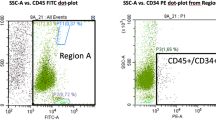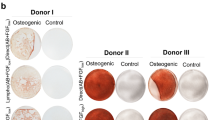Abstract
Cadaveric bone marrow was harvested from 20 brain-dead donors to determine optimal conditions for procurement for transplantation. The number of nucleated cells obtained from 1 ml of bone marrow was significantly higher in vertebrae (87 ± 20 × 106, mean ± s.e.m.) than in the sternum (10.2 ± 3.8 × 106) or ribs (4.9 ± 2.0 × 106). Viability of cells was not significantly affected by storage temperature (4°C or 20°C) or duration of storage (6–72 h). In addition to bone marrow, spleen cells were harvested from three cadaveric donors. The mean yield from 1 g of spleen tissue was 4.4 × 106 nucleated cells. Using magnetic beads, we removed 96% of T lymphocytes without affecting the total yield of stem cells from cadaveric bone marrow. Using CD34-positive cell selection, we obtained a 99.6% T cell depletion efficiency, but with a loss of 60% of CD34-positive cells. Using optimized techniques, we obtained an estimated mean yield of 5.5 × 1010 mononuclear cells from the whole thoracic and lumbar vertebral column. With a mean fraction of CD34-positive cells of 2.1 ± 0.3%, recovery and purity were not affected by site of sample, temperature or donor age. In contrast, the CD34-positive fraction in spleen preparations was 0.41 ± 0.06%. When analyzing the number of colony-forming units (CFU-GM, BFU-E and CFU-GEMM), we found no significant differences between cadaveric bone marrow and bone marrow aspirates from living donors. However, cells harvested from the spleen gave significantly fewer CFUs than did bone marrow from living donors. We conclude that bone marrow from cadaveric donors can be harvested and procured with a high degree of viability and good function. With an appropriate technique of harvesting and procurement, it seems feasible to recover enough stem cells for transplantation.
This is a preview of subscription content, access via your institution
Access options
Subscribe to this journal
Receive 12 print issues and online access
$259.00 per year
only $21.58 per issue
Buy this article
- Purchase on Springer Link
- Instant access to full article PDF
Prices may be subject to local taxes which are calculated during checkout
Similar content being viewed by others
Author information
Authors and Affiliations
Rights and permissions
About this article
Cite this article
Söderdahl, G., Tammik, C., Remberger, M. et al. Cadaveric bone marrow and spleen cells for transplantation. Bone Marrow Transplant 21, 79–84 (1998). https://doi.org/10.1038/sj.bmt.1701039
Received:
Accepted:
Published:
Issue Date:
DOI: https://doi.org/10.1038/sj.bmt.1701039
Keywords
This article is cited by
-
Ischemia considerations for the development of an organ and tissue donor derived bone marrow bank
Journal of Translational Medicine (2020)
-
A quantitative assessment of the content of hematopoietic stem cells in mouse and human endosteal-bone marrow: a simple and rapid method for the isolation of mouse central bone marrow
BMC Hematology (2015)



